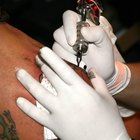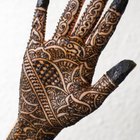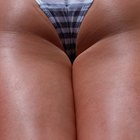
New tattoos are usually sensitive for the first week or so after you get the tattoo. Additionally, they may be raised for awhile after the tattooing procedure is done. Tattoos appear raised because your pores swell once they are filled with ink. This is your body's way of trying to heal after the trauma that it has endured. However, there are a few things that you can do to reduce the raised skin, and to help the tattooed area heal as quickly as possible. According to Bret, the owner of Celtic Tattoo in Newport Rhode Island, tattoo after care is important for the longevity of your tattoo and your health.
Follow any special instructions that your tattoo artist has given you. Leave the bandage on the tattoo until you get home, which should be no longer than two hours after getting the tattoo. Use a clean tissue to wipe away any ointment and body fluid that cover the tattoo.
Wash your hands and apply a new layer of A&D ointment. If your tattoo continues to ooze fluid, wipe it away and reapply ointment. Don’t allow the fluid to sit on the tattoo as this can cause infection. The fluid seeps out because your body is trying to rid itself of possible infection. You may have to repeat this process several times for the first two or three hours after getting your tattoo. Do not re-bandage the tattoo.
Keep the tattoo dry. Get it wet as little as possible. Warm water especially will open up pores and will allow for dirt and bacteria to enter more easily. When you get out of the shower, pat the tattoo dry with a clean cloth or paper towel. Use petroleum jelly to cover the tattoo when you shower. This product will keep water from saturating the tattoo. Wipe it off immediately after you shower. If you leave the petroleum jelly on for too long, it can pull the ink out of the tattoo.
Moisturize your tattoo several times a day with A&D or triple antibiotic ointment for the first five days and up to one week. If your tattoo is still drying out, switch to a non-scented lotion and apply four or five times per day. Lotions with scent will irritate your tattoo as opposed to hydrating it. Your tattoo will remain raised until it has healed and is likely to peel and flake.
Prevent flaking and extra inflammation by applying more ointment to drier areas. Though some flaking is normal, excess flaking is a sign that your skin is too dry. If you allow this to go on, you may need a tattoo touch up in the future as your skin will shed more of the tattoo ink.
Avoid touching your tattoo. Your fingers carry a lot of bacteria and you are likely to spread this bacteria by touching the tattoo. If you find yourself in an environment where you are exposed to large amounts of bacteria, namely places that contain large amounts of people, keep your tattoo covered with a non-stick bandage or by wearing clothing that covers the tattoo. Non-stick bandages are important as the adhesive variety can harm the tattoo upon removal.
Apply an ice pack if your tattoo is very raised. Excessively raised tattoos imply infection and you will want to reduce the size as soon as possible. Visit your tattoo artist for questions. Visit your doctor if the tattoo becomes painful or stays excessively raised for more than a day or so. You may need antibiotics to cure a possible skin infection.
Related Articles

How to Shower With a New Tattoo

How to Clean a Tattoo With ...

What Happens to Tattoos as You Age?

How to Clean Tattoos With Rubbing ...

How Long After a Tattoo Can I Put ...

How to Use Tattoo Goo

How to Unstick Clothing From Tattoo

How to Remove Henna Tattoos Quickly

How to Take Care of a Colored Tattoo ...

How to Prevent a New Tattoo From ...

Why Does Ink Come Out of a Tattoo?

How to Cover a New Tattoo So You Can ...

How to Protect a Tattoo From the Sun

How to Get Rid of a Tattoo Scab

How to Fade a Tattoo at Home

How to Darken a Henna Tattoo

How to Care for an India Ink Tattoo

Parts of My Tattoo Are Getting Lighter

Things That Fade Tattoo Ink

How to Heal a Bikini Razor Burn
Writer Bio
Crystal Lassen hails from Kansas City, Mo. and has been a book critic since 2008. Her reviews have appeared on the Publisher's Weekly website and are largely concerned with current events. She holds a Bachelor of Arts degree in English with an emphasis in creative writing from The University of Kansas.
Photo Credits
Ablestock.com/AbleStock.com/Getty Images